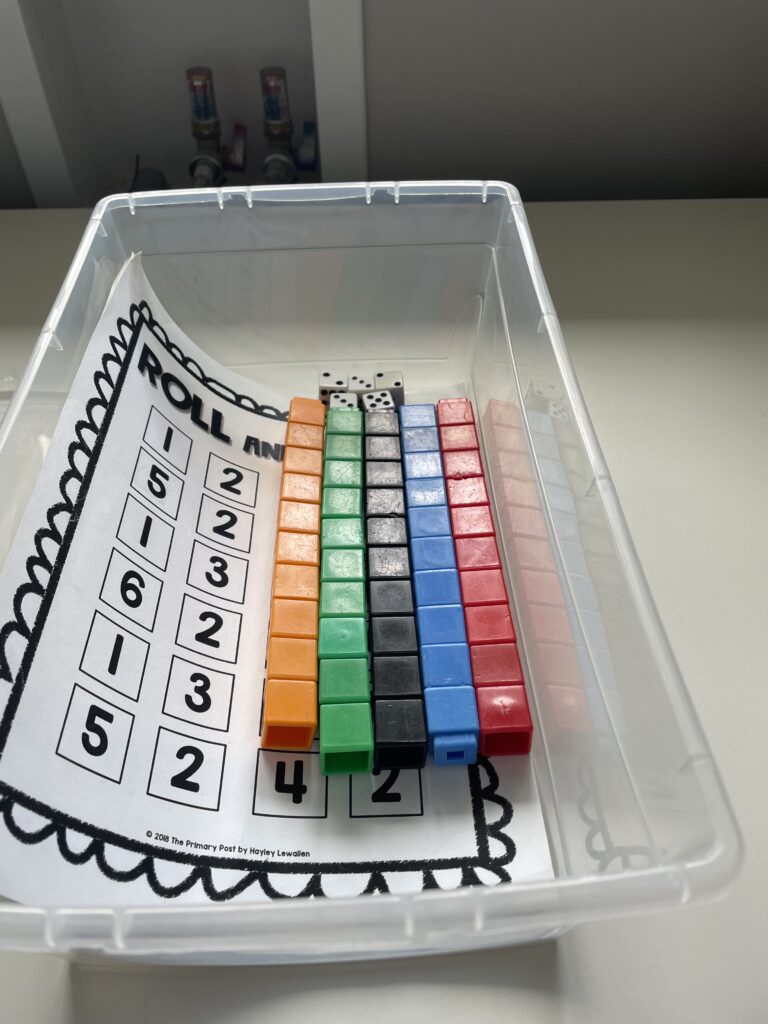” Somewhere down the line, learning became not fun.”
Game Based Learning
When I heard this quote in the “Game Based Learning” video I sunk deep into my chair. Do learners entering my room feel this way about learning? This made me reflect on what I do for learning and how I make it engaging and effective.
In our space, I have created “Exploration Bins” where we explore numbers and letters in a game-like or play fashion.

These bins are very low stakes and they can be differentiated as the learners need. They also allow me to move around the classroom and monitor learning and offer guidance if needed. They also allow me to have an interpretive role where I can ask , “what can I learn about the student’s thinking by attending carefully to what she just said?” (Black & Wiliam, 2014) This way I am formatively assessing where my learners are at so that I can build more learning resources to guide them to where they need to go.
In this bin, each learner will pick a colour and a partner and choose one sheet. Their job is to roll the die, build that amount of blocks and place it on the corresponding digit. Once a player places their blocks on the digit no one else can go there. The goal of the game is to have the most amount of spots filled on the sheet once you no longer have any cubes.
Here, learners who are just beginning to recognize digits will be happy with this. But as an extension to those who are further along in their number sense, they can grab two dice and add them together to find where to put their blocks. I realized, that I do gamify in my classroom and that these bins truly keep them engaged and entertained.
That being said, I learned from this weeks learning materials that I have NOT flipped my classroom, but I now have ideas how I will. I love the idea of sending home the learning resources through videos, readings or tasks to respond to via something like Padlet or Polleverywhere. This way, I can have my learners prepped about what is happening in the class and have exciting and interactive tasks for them to DO in class. Not only that, but I can have a basic understanding of what they know coming into a lesson. If I know what they know or do not know, I can start there and move forward. Rather than potentially reteaching something they know and boring them to tears.

I have been following a teacher on Instagram called Trevor Mackenzie, aka @tntmackenzie, and he has just written a book on Student ownership of Assessment. If you have a chance to check him out, he is a great resource, and so are his books. Below is a sketchnote that I use as a reminder for myself.

Citation
Game Based Learning. (2021, May) University of Toronto. https://guides.library.utoronto.ca/c.php?g=448614&p=3507705
Black, P., & Wiliam , D. (2014). Assessment and the Design of Educational Materials. https://www.educationaldesigner.org/ed/volume2/issue7/article23/.
Mackenzie, Trevor. (2021). Instagram. https://www.instagram.com/tntmackenzie/?hl=en


https://omar-elhalabi.opened.ca/2021/06/13/blog-6-different-types-of-assessment-for-learners/
Hi Omar,
Thank you for yet another well written and insightful post.
You wrote, “I often found classes that relied heavily on summative assessment to be quite difficult. I feel that as students our knowledge of the material shouldn’t all count towards one examination. By breaking up the learning into manageable blocks and taking a formative approach for assessment, I believe this is a much more efficient way in students retaining information.”
This is incredible insight. I also believe this is so important. It should not be about one exam, but the journey to get there and the knowledge gained throughout. When we formatively assess, we can see the learners where they are at and help them get to where they need to be. Because all learners are different and are at different stages in their learning, “conferences” and “check ins” allow instructors to guide individuals in their unique needs to their unique destinations.
I do still believe in a summative assessment in areas. However, that assessment can be engaging and exciting to the learners if it is created together and will inspire them to produce something meaningful. Therefore, I always try to make a final assessment a multimedia museum of learning. By that I mean, learners can demonstrate their learning in a way that best suits them and their needs, in a museum night where others can come to learn from them as experts. It is much like what we are doing for this course. We have learned the basics of the programs and tools, and now we can display our learning by creating something that is meaningful to us in hopes to educate others.
Thanks again for your thinking. I love reading your weekly posts and always gain something from them.
Hi Jayne, I think in your context, another great part of flipping the classroom is involving parents in their kids’ learning. While I’m sure you keep the ‘homework’ to pretty short chunks in your class, as a parent I always love being a direct participant in my kids’ learning, and especially so when the task is to consume something (watch, read, etc) and then talk about it. It also helps to get around the dinnertime conversation which often goes: “What did you learn at school today?” “Nuthin'” lol.